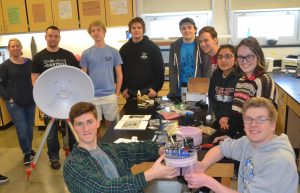Rubber bands, masking tape, gadgets that cut strings, a helium balloon, a parachute, a tiny camera and a satellite are a few of items Silverton High School students are using to create a once-in-a-lifetime experience.
Teacher Creighton Helms said 35 students are participating on the SHS NASA High Altitude Balloon Project. There are seven high schools nationwide participating in the NASA science experiment, including four in Oregon.
The students, Helms said, are given the task to build, launch and recover a high altitude balloon that will gather information and capture the eclipse for NASA. The balloon will reach 90,000 to 100,000 feet – higher than a commercial airplane flies – to record the total solar eclipse on Aug. 21.
“A total solar eclipse is a relatively rare astronomical event,” Helms said.
Helms credits Silverton resident Rick Krause of the South Metro-Salem STEM Partnership for his role in helping Silverton High participate in the NASA project.
High Altitude Balloon Project
Twitter:@SilvertonHAB
Instagram: SilvertonHAB
Web: www.shshab.weebly.com
Snapchat: Silvertonhab
The SHS NASA High Altitude Balloon Project members are divided into five teams – build, launch, journalism, chase and K-8 project representatives.
“Everyone who signed up to participate on the project was able to do so,” Helms said.
The build team members are Darren Buckley, Andrea Fernando Campos, Abby Gisler, Matthew McWhorter, Jason Orr, Gavin Owings, Isaac Rush and Sebastian Rogg.
The launch team members are Steven Bates, Hannah Brown, Nathan Capiner, Nate Edmonds, Carolina Gaspar, John Wayne Mikel Jr., Brigitta Seifer and Alejandra Vazques-Trejo.
The journalism team members are Alexa Hall, Abigail Koch, Brian Sung and Ben Valoff.
The chase team members are Ben Amsden, Isabelle Doan, Amber Fairbairn, Sam Miller, Gaig Morgan, Derek Schmaltz and Amelia Underhill.
The K-8 Project Representatives are Chandler Gartner, Cooper Hammond, Michael Kofstad, Procopie Barsuleuff, Caleb Reader and Jon Rivoli.
Helms thanked James Dahl, who is in the Basic Skills class, for helping make the team T-shirts.
On a recent Saturday the build and journalism teams met to work on the project.
With the goal of being an aerospace engineer, Ownings said the project is giving him valuable, real life experience.
A photographer, Amsden said he’s excited to be able to photograph and write about the experiment. The journalism team has several social media accounts so community members can follow the project.
For students like Orr, this represents a chance to work with NASA.
“I am really interested in engineering,” he said
Orr and Ownings both said although they were given instructions on how to assemble the various devices, the instructions were not “step-by-step.”
“We have had to do some problem-solving,” Orr said. “We are having to apply what we have learned to figure out how to solve the problems.”
Juniors Campos and Gisler both said they have always liked to build things and enjoy math and science classes. They also would like to work at NASA.
Campos said working on the NASA project will provide her with insight on whether this is what she wants to do.
“I want to have a career that I am passionate about,” she said. “What I like about this project is we are required to collaborate and do some problem solving.”
Both Campos and Gisler like they are working on a hands-on project.
“We are using some of what we are learning in the classroom,” Gisler said.
Math teacher Natasha Beliakoft and science teachers Emily Perttu and Clarissa Bay are helping Helms with the project. Catherine Lanier is the Oregon NASA Space connection.
“What I have enjoyed about working with the students is seeing them problem solve, trouble shoot and look at the possibilities,” Beliakoft said. “The students also worked as a team and everyone was hands-on.”
Beliakoft said students often ask why they need to know what they are learning in the classroom.
“This project with NASA answers that question,” she said. “How many times do students get a chance to connect with NASA?”
Rush said his experience building with Legos and cars has helped him with this project, even though it used rubber bands and masking tape.
“We knew this project was working when the lights went on,” he said
The students will continue to work on Saturdays as well as visit with kindergarten through eighth grade students to share news about the project.
